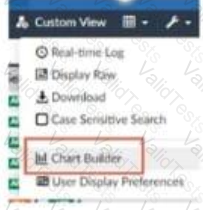Which daemon is responsible for enforcing raw log file size?
View the exhibit:

What does the 1000MB maximum for disk utilization refer to?
Which two methods are the most common methods to control and restrict administrative access on FortiAnalyzer? (Choose two.)
View the exhibit.

Why is the total quota less than the total system storage?
What can the CLI command # diagnose test application oftpd 3 help you to determine?
Which statement describes online logs on FortiAnalyzer?
Which two statements about log forwarding are true? (Choose two.)
Refer to the exhibit.

What is the purpose of using the Chart Builder feature on FortiAnalyzer?
Which statements are true of Administrative Domains (ADOMs) in FortiAnalyzer? (Choose two.)
Which two statements are true regarding FortiAnalyzer log forwarding? (Choose two.)